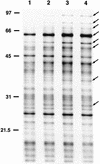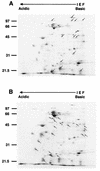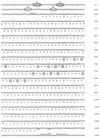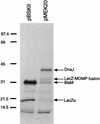Characterization of the thermal stress response of Campylobacter jejuni
- PMID: 9673247
- PMCID: PMC108400
- DOI: 10.1128/IAI.66.8.3666-3672.1998
Characterization of the thermal stress response of Campylobacter jejuni
Abstract
Campylobacter jejuni, a microaerophilic, gram-negative bacterium, is a common cause of gastrointestinal disease in humans. Heat shock proteins are a group of highly conserved, coregulated proteins that play important roles in enabling organisms to cope with physiological stresses. The primary aim of this study was to characterize the heat shock response of C. jejuni. Twenty-four proteins were preferentially synthesized by C. jejuni immediately following heat shock. Upon immunoscreening of Escherichia coli transformants harboring a Campylobacter genomic DNA library, one recombinant plasmid that encoded a heat shock protein was isolated. The recombinant plasmid, designated pMEK20, contained an open reading frame of 1,119 bp that was capable of encoding a protein of 372 amino acids with a calculated molecular mass of 41,436 Da. The deduced amino acid sequence of the open reading frame shared similarity with that of DnaJ, which belongs to the Hsp-40 family of molecular chaperones, from a number of bacteria. An E. coli dnaJ mutant was successfully complemented with the pMEK20 recombinant plasmid, as judged by the ability of bacteriophage lambda to form plaques, indicating that the C. jejuni gene encoding the 41-kDa protein is a functional homolog of the dnaJ gene from E. coli. The ability of each of two C. jejuni dnaJ mutants to form colonies at 46 degreesC was severely retarded, indicating that DnaJ plays an important role in C. jejuni thermotolerance. Experiments revealed that a C. jejuni DnaJ mutant was unable to colonize newly hatched Leghorn chickens, suggesting that heat shock proteins play a role in vivo.
Figures






Similar articles
-
Cloning and characterization of the dnaK heat shock operon of the marine bacterium Vibrio harveyi.Mol Gen Genet. 1998 Aug;259(2):179-89. doi: 10.1007/s004380050803. Mol Gen Genet. 1998. PMID: 9747709
-
Nucleotide sequence analysis and heterologous expression of the Erysipelothrix rhusiopathiae dnaJ gene.FEMS Microbiol Lett. 1993 Jul 15;111(1):79-85. doi: 10.1111/j.1574-6968.1993.tb06365.x. FEMS Microbiol Lett. 1993. PMID: 8359682
-
Cloning, nucleotide sequence, and regulatory analysis of the Lactococcus lactis dnaJ gene.J Bacteriol. 1993 Mar;175(6):1637-44. doi: 10.1128/jb.175.6.1637-1644.1993. J Bacteriol. 1993. PMID: 8449872 Free PMC article.
-
Bacterial cold-shock proteins.Cell Mol Life Sci. 2002 Nov;59(11):1902-13. doi: 10.1007/pl00012513. Cell Mol Life Sci. 2002. PMID: 12530521 Free PMC article. Review.
-
The heat shock protein response and its role in inflammatory disease.Ann Rheum Dis. 1990 Feb;49(2):128-32. doi: 10.1136/ard.49.2.128. Ann Rheum Dis. 1990. PMID: 2180385 Free PMC article. Review. No abstract available.
Cited by
-
Environmental regulation of Campylobacter jejuni major outer membrane protein porin expression in Escherichia coli monitored by using green fluorescent protein.Appl Environ Microbiol. 2002 Sep;68(9):4209-15. doi: 10.1128/AEM.68.9.4209-4215.2002. Appl Environ Microbiol. 2002. PMID: 12200267 Free PMC article.
-
DnaJ and ClpX Are Required for HitRS and HssRS Two-Component System Signaling in Bacillus anthracis.Infect Immun. 2022 Jan 25;90(1):e0056021. doi: 10.1128/IAI.00560-21. Epub 2021 Nov 8. Infect Immun. 2022. PMID: 34748369 Free PMC article.
-
Campylobacter jejuni gene cj0511 encodes a serine peptidase essential for colonisation.FEBS Open Bio. 2014 May 9;4:468-72. doi: 10.1016/j.fob.2014.04.012. eCollection 2014. FEBS Open Bio. 2014. PMID: 24918062 Free PMC article.
-
Prevalence of Virulence/Stress Genes in Campylobacter jejuni from Chicken Meat Sold in Qatari Retail Outlets.PLoS One. 2016 Jun 3;11(6):e0156938. doi: 10.1371/journal.pone.0156938. eCollection 2016. PLoS One. 2016. PMID: 27258021 Free PMC article.
-
Analysis of resistance to antimicrobials and presence of virulence/stress response genes in Campylobacter isolates from patients with severe diarrhoea.PLoS One. 2015 Mar 17;10(3):e0119268. doi: 10.1371/journal.pone.0119268. eCollection 2015. PLoS One. 2015. PMID: 25781009 Free PMC article.
References
-
- Bardwell J C A, Tilly K, Craig E, King J, Zylicz M, Georgopoulos C. The nucleotide sequence of the Escherichia coli K12 dnaJ+ gene: a gene that encodes a heat shock protein. J Biol Chem. 1986;261:1782–1785. - PubMed
Publication types
MeSH terms
Substances
Associated data
- Actions
Grants and funding
LinkOut - more resources
Full Text Sources

